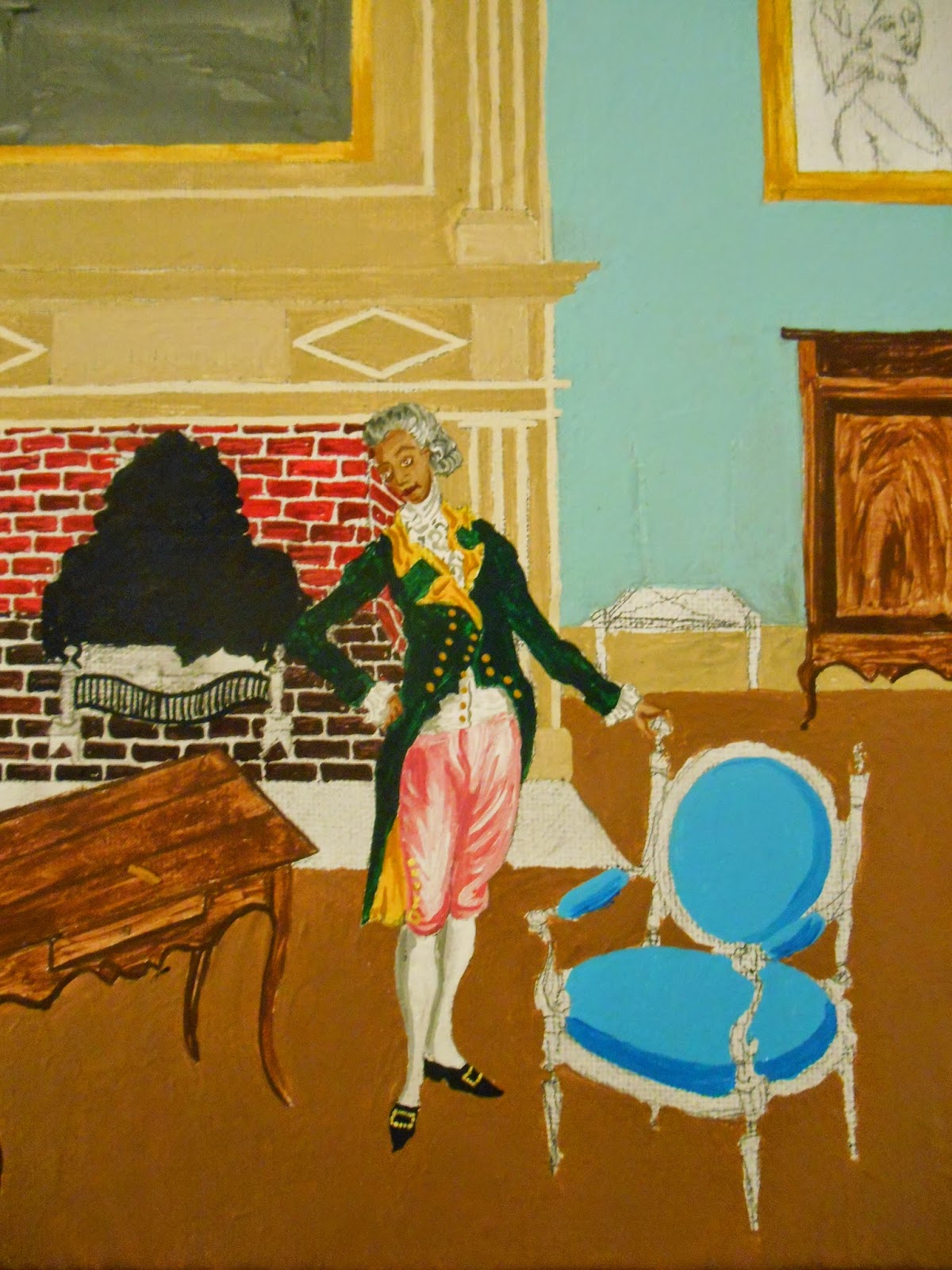"La Maison du Free Man of Color" by Andrew LaMar Hopkins
One of my favorite paintings titled "La Maison du Free Man of Color" sold about a week ago at Nadine Blake's along with 6 others over a 48 hour period. "La Maison du Free Man of Color" is the first of my paintings I documented from beginning to end. Lot's of people want to know how I paint a painting from start to finish. I decided to start a facebook page to document my art and the steps in making it. Being self taught and not academically trained I have my own way of painting that is very different from formally trained artist. Instead of painting on a easel I paint with the canvas on my lap. Because of this I don't paint on stretched canvas, I love canvas board.
"La Maison du Free Man of Color" shows a well appointed late 18th century
Creole salon of a Creole gentleman of color. He is fashionably dressed in
the latest fashion from France including a powdered wig. His parents
portraits are over the Louisiana made French styled chest. A mother of African descent and a French
aristocrat father.
A portrait of the Creole gentleman of color as a child in a gilt
wood Louis XV frame hangs over the mantel. The Creole mantle and over mantel
are copied from Columbia Plantation 1782. 18th century Louisiana inventories
of interiors list locally made pieces of furniture Like the Creole
armoire, a Louisiana walnut pied-de-biche center table and the chest with
Cabriole Legs were mixed with fine imported furniture from France like the Louis
XVI gilded sofa and arm chair.
Other imported items in the room are
decorative arts like the blue and white delft vases on the mantel. The French cast
iron fireback in the fireplace. The Louis XV mantel clock, The Louis XVI
gilt wood mirror over the mantel. The French faïence pottery on the chest
and silver candlesticks would have been fancy items available in a port city
like New Orleans.
The term free people of color (French: gens de couleur
libres), at first specifically referred to persons of partial African and
European descent who were not enslaved. The term was especially used in the
French colonies, including La Louisiane and settlements on Caribbean
islands, such as Saint-Domingue, Guadeloupe, and Martinique.
Free people of
color developed as a separate class between the colonial French and Spanish and
the enslaved black African workers. They often achieved education and some
measure of wealth; they spoke French and practiced Catholicism,
The first step. The drawing of La Maison du Free Man of Color before paint is applied.
Most of the decorative arts and furniture are picked out of my vast collection of photo's of antiques. While other items are latter added while the painting is still being painted.
Step 2, I try to cover the drawing all in paint. Note the Louisiana ladder back chairs are painted out from the drawing.
3, Some finer details are painted right away like the fabrics in the clothing while others just have base paint like the fabric on the chair to be latter touched up.
Now the portraits come alive in the painting. One of the number 1 things people love about my paintings are the portraits and paintings in my paintings.
4, Now stuff pops into the paintings that was not in the original drawing. Like the blue and white delft vases on the mantel. The Louis XV mantel clock, The French faïence pottery on the chest.
5, The French Louis XVI arm chair now has it's gilding
6, Finishing touches are added to the painting and then it is varnished!
"La Maison du Free Man of Color" by Andrew LaMar Hopkins complete.
My painting centers around the Creole 18th century mantle and over mantel
copied from Columbia Plantation circa 1782. A early Louisiana Colonial house now being restored. The photo by Jacques Levet Jr.
Detail of the wonderful gouge work on Columbia Plantation mantel. photo by Jacques Levet Jr.
Detail of the wonderful gouge work on Columbia Plantation mantel. photo by Jacques Levet Jr.
Columbia Plantation circa 1782. photo by Jacques Levet Jr.
18th century French portrait of a boy that I turned into a Free boy of color in my painting
18th century French Louis XVI mirror used in my painting
A French Louis XVI gilded arm chair.
A 18th century Louisiana walnut pied-de-biche center table with
Cabriole Legs
cast iron & brass fireback and grate
Louisiana Armoire with Inlay. Mahogany, Tulip Poplar, Yellow Pine, Satinwood, Holly & Maple. Pied de Biche Feet on Cabriole Legs.
French Louis XVI Giltwood Canape
Jean-Etienne Liotard (1702-1789) - Portrait of a Young Woman. Oil on Canvas. France. Circa Mid-18th Century.
French 18th century portrait of a French
aristocrat.
A Louisiana walnut pied-de-biche chest with
Cabriole Legs
"La Maison du Free Man of Color" by Andrew LaMar Hopkins
You can follow my art on facebook at
https://www.facebook.com/andrewhopkinsfolkart












































No comments:
Post a Comment